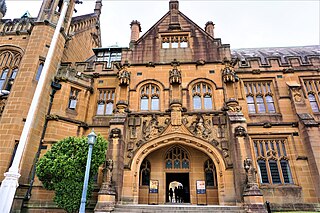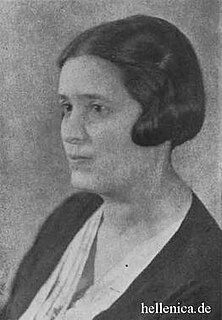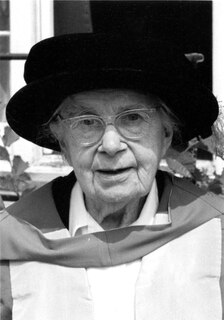Related Research Articles

The Nicholson Museum was an archaeological museum at the University of Sydney home to the Nicholson Collection, the largest collection of antiquities in both Australia and the Southern Hemisphere. Founded in 1860, the collection spans the ancient world with primary collection areas including ancient Egypt, Greece, Italy, Cyprus, and the Near East. The museum closed permanently in February 2020, and the Nicholson Collection is now housed in the Chau Chak Wing Museum at the University of Sydney, open from November 2020. The museum was located in the main quadrangle of the University.

Ancient Greek pottery, due to its relative durability, comprises a large part of the archaeological record of ancient Greece, and since there is so much of it, it has exerted a disproportionately large influence on our understanding of Greek society. The shards of pots discarded or buried in the 1st millennium BC are still the best guide available to understand the customary life and mind of the ancient Greeks. There were several vessels produced locally for everyday and kitchen use, yet finer pottery from regions such as Attica was imported by other civilizations throughout the Mediterranean, such as the Etruscans in Italy. There were a multitude of specific regional varieties, such as the South Italian ancient Greek pottery.

The Benaki Museum, established and endowed in 1930 by Antonis Benakis in memory of his father Emmanuel Benakis, is housed in the Benakis family mansion in downtown Athens, Greece. The museum houses Greek works of art from the prehistorical to the modern times, an extensive collection of Asian art, hosts periodic exhibitions and maintains a state-of-the-art restoration and conservation workshop. Although the museum initially housed a collection that included Islamic art, Chinese porcelain and exhibits on toys, its 2000 re-opening led to the creation of satellite museums that focused on specific collections, allowing the main museum to focus on Greek culture over the span of the country's history. This Museum in Athens houses over 100,000 artifacts from Greek history and showcases the many eras, civilizations and cultures which have influenced the development of Greece. Spread over a number of locations, the museum ranks among Greece’s foremost cultural institutions.

Sophilos was an Attic potter and vase painter in the black-figure style. Sophilos is the oldest Attic vase painter so far to be known by his true name. Fragments of two wine basins (dinoi) in Athens are signed by him, indicating that he both potted and painted them. In total, 37 vessels are ascribed to him, mostly amphorae, dinoi, kraters, as well as three pinakes. Apart from his work for the domestic market, he was also one of the masters of major significance in the process of supplanting the dominance of Corinthian vase painting in the markets of Etruria, and Southern Italy, the most important export area for Greek vases. His works were exported as far as the Black Sea region, Syria and Egypt (Naukratis).

Corpus Vasorum Antiquorum is an international research project for documentation of ancient ceramics. Its original ideal target content: any ceramic from any ancient location during any archaeological period, proved impossible of realization and was soon restricted to specific times and periods. As the project expanded from an original six nations: England, Belgium, Denmark, France, the Netherlands, and Italy. to include the current 28, the topic specializations of each country were left up to the commission for that country. The French commission, serves in an advisory position.
Edmond François Paul Pottier was an art historian and archaeologist who was instrumental in establishing the Corpus vasorum antiquorum. He was a pioneering scholar in the study of Ancient Greek pottery.
Richard MacGillivray Dawkins FBA was a British archaeologist. He was associated with the British School at Athens, of which he was Director between 1906 and 1913.
Robert Manuel Cook, was a classical scholar and classical archaeologist from England with expertise in Greek painted vases. He was Laurence Professor of Classical Archaeology at the University of Cambridge, the author of several academic texts and was elected a Fellow of the British Academy in 1974, having been made a Fellow of the German Archaeological Institute in 1953.
Charles Martin Robertson was a British classical scholar and poet. He specialised in the art and archaeology of Ancient Greece.
Percy Neville Ure M.A. was the University of Reading's first Professor of Classics (1911–1946) and the founder of the Ure Museum of Greek Archaeology at Reading. His wife and former pupil at Reading, Annie Ure (1893–1976), was the museum's first Curator from 1922 until her death. The Ures were experts on Greek and Egyptian antiquities, and particularly Greek ceramics. With Ronald M. Burrows, they undertook important excavations at Rhitsona in Boeotia, Greece.

Winifred Lamb was a British archaeologist, art historian, and museum curator who specialised in Greek, Roman, and Anatolian cultures and artefacts. The bulk of her career was spent as the honorary keeper (curator) of Greek antiquities at the University of Cambridge's Fitzwilliam Museum from 1920 to 1958, and the Fitzwilliam Museum states that she was a "generous benefactor ... raising the profile of the collections through groundbreaking research, acquisitions and publications."
Richard Theodore Neer is William B. Ogden Distinguished Service Professor in Art History, Cinema & Media Studies and the College, and an affiliate of the Department of Classics, at the University of Chicago. Neer is also Executive Editor of Critical Inquiry.
Dyfri Williams is a British classical archaeologist. Williams received his doctorate in 1978 from Oxford University, writing on the work of the Antiphon Painter. He joined the Department of Antiquities at the British Museum in 1979. From 1993 to 2007, he was the museum's Keeper of Greek and Roman Antiquities. Since December 2007 he has been the research Keeper.
Irma Wehgartner is a German Classical archaeologist.

Semni Papaspyridi-Karouzou was a Greek classical archaeologist who specialized in the study of pottery from ancient Greece. She was the first woman to join the Greek Archaeological Service; she excavated in Crete, Euboea, Thessaly, and the Argolid, and worked as Curator of ceramic collections at the National Archaeological Museum in Athens for over thirty years. She experienced political persecution under the Greek military junta of 1967-1974. She has been described by the archaeologists Marianna Nikolaidou and Dimitra Kokkinidou as "perhaps the most important woman in Greek archaeology", and by the newspaper To Vima as "the last representative of the generation of great archaeologists".
Ann Wheeler Harnwell Ashmead is an American archaeologist who has co-authored comprehensive catalogues with the archaeologist Etruscologist Kyle Meredith Phillips, Jr. about the Greek Vase Painting collections of Bryn Mawr College (1971) and the Rhode Island School of Design (1976). She has also written the main published catalogue for the Antiquities Collection of Haverford College (1999). and many articles on Greek Vases.
Jenifer Neils is an American classical archaeologist and since July 2017 director of the American School of Classical Studies at Athens. Formerly she was the Elsie B. Smith Professor in the Liberal Arts in the Department of Classics at Case Western Reserve University.
Maria Ludwika Bernhard was a Polish classical archaeologist and a specialist in Greek Art. During the German Occupation of Poland in World War II, Bernhard was living in Warsaw and was active in the Polish Resistance Movement. After the war, Bernhard was a Professor of Classical Archaeology at the University of Warsaw. In 1957 she became the chair of the Department of Classical Archaeology at Jagiellonian University. She was also curator of the Ancient Art gallery at the National Museum in Warsaw from 1945 to 1962.

Amy C. Smith is the current Curator of the Ure Museum of Greek Archaeology and Professor of Classical Archaeology at Reading University. She is known for her work on iconography, the history of collections, and digital museology.

Annie Dunman Ure was an English archaeologist, who from 1922 to 1976 was the first Curator of the Ure Museum of Greek Archaeology. She and her husband Percy Ure conducted important excavations at Ritsona in Boeotia, Greece, making her one of the first female archaeologists to lead an excavation in Greece.
References
- ↑ Research Programmes. Academy of Athens, 2012. Retrieved 19 May 2012.
- ↑ Victoria Sabetai, Books. Academia.edu. Retrieved 19 May 2012.